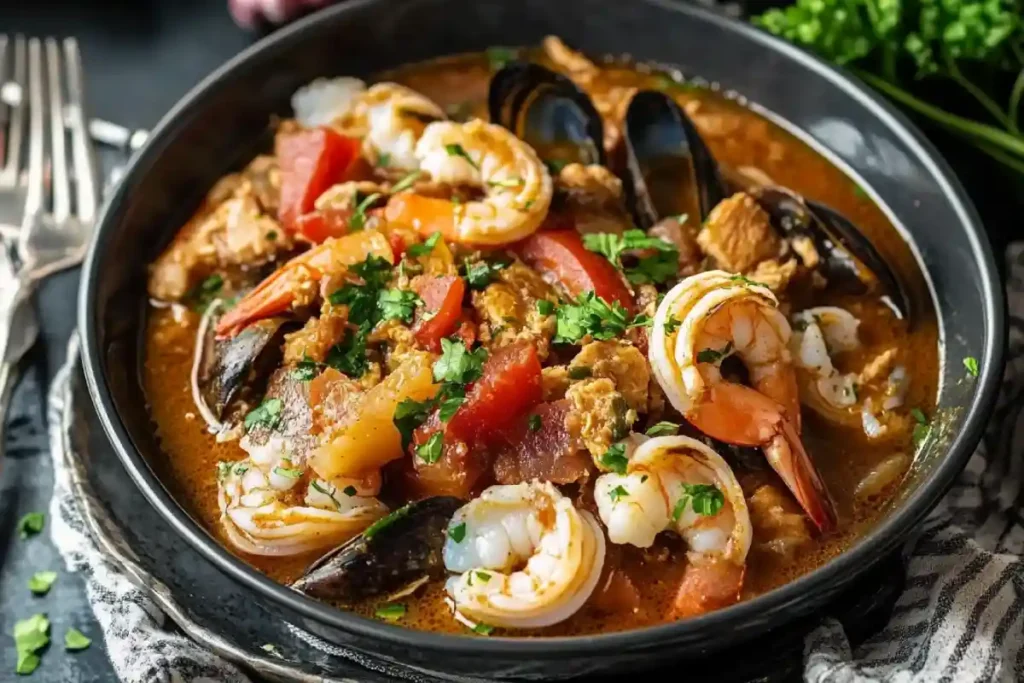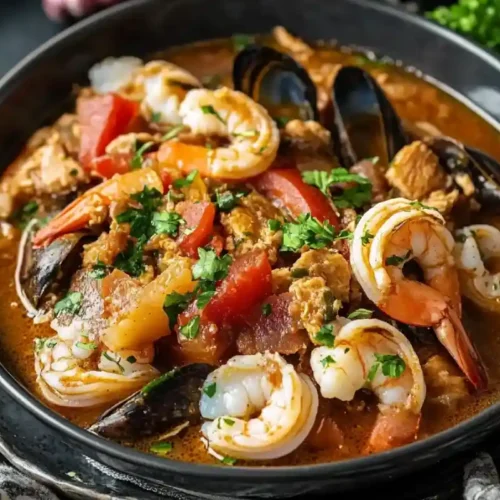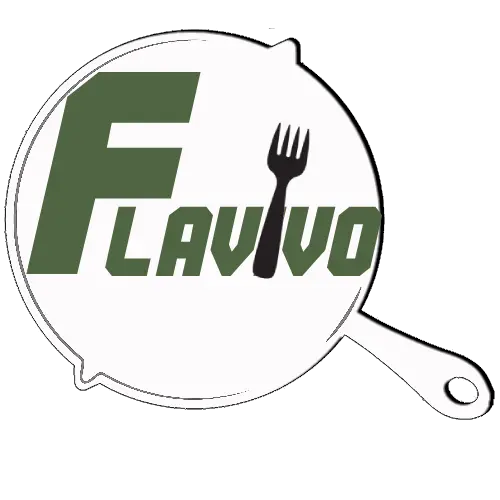
Table of Contents
Why choose between surf and turf? This chicken and seafood gumbo recipe browns bone-in thighs for sticky fond, then folds in Gulf shrimp and lump crab near the finish so every bite pops with briny sweetness. Three test pots locked a deep-chocolate roux and 50-minute simmer that leaves chicken juicy and seafood perfectly tender.
Key Ingredients in a Chicken and Seafood Gumbo Recipe
To build the perfect chicken and seafood gumbo recipe, you must start with the right ingredients. Each component plays an important role, not only in flavor but also in texture and depth. Therefore, understanding these elements helps ensure your gumbo turns out rich and authentic.
First and foremost, you need a well-made roux. This simple mix of flour and oil acts as the flavor foundation of any gumbo. Stirred carefully over medium heat, the roux transforms into a rich, brown base that deepens the taste of the dish.
Next comes the Holy Trinity—a blend of chopped:
- Onions
- Celery
- Bell peppers
This trio of vegetables brings balance, sweetness, and a savory backbone to the gumbo. Along with them, you’ll add fresh garlic and a pinch of cayenne to elevate the heat.
When it comes to proteins, a standout chicken and seafood gumbo recipe typically includes:
- Chicken thighs (for tender, juicy meat)
- Shrimp (added last for a soft texture)
- Andouille chicken sausage (smoky and bold)
- Optional: crab or crawfish for extra seafood richness
In traditional Louisiana recipes, okra and filé powder serve as thickeners. While okra adds body and subtle earthiness, filé—made from sassafras leaves—offers a slightly herbal finish. You can use either, or both, depending on your taste.
For those who enjoy exploring Southern flavor combos, you might want to try this canned red beans and rice with sausage recipe as a flavorful side. It complements gumbo beautifully, especially when served over rice.
Altogether, these ingredients blend into a dish that’s bold, savory, and unforgettable. When chosen and prepared with care, they transform a simple pot of soup into an iconic Southern experience.
Shrimp, Chicken, and Sausage – The Trifecta
One of the most iconic features of any chicken and seafood gumbo recipe is its use of not one—but three—key proteins: shrimp, chicken, and sausage. Each of these ingredients adds a distinct layer of flavor and texture. When combined, they form what many refer to as “The Trifecta” of gumbo. While you can make gumbo with just one or two proteins, using all three ensures a richer and more complex taste.
Let’s take a closer look at what each brings to the pot:
Why This Combo Works So Well
- Shrimp offers a delicate, briny sweetness that balances the boldness of the roux and spices.
- Chicken, especially thighs, adds a tender, meaty bite that holds up during long simmering.
- Andouille chicken sausage introduces a smoky, spicy kick that deepens the overall flavor.
Although you could use other meats or seafood, this trio provides a dependable and delicious foundation. It’s worth noting that many classic Louisiana dishes also use these ingredients, which further highlights their regional popularity and culinary value.
Here’s a quick breakdown:
| Protein | Flavor Profile | When to Add | Texture After Cooking |
|---|---|---|---|
| Shrimp | Sweet, briny | Near the end | Tender, juicy |
| Chicken (thighs) | Mild, savory | Early in the simmer | Juicy, fall-apart tender |
| Chicken Sausage | Smoky, spicy | Early, after browning | Firm, bold |
Because of their complementary qualities, using all three ensures that your chicken and seafood gumbo recipe is layered, satisfying, and authentically Southern.
Step-by-Step Chicken and Seafood Gumbo Recipe
Making a flavorful chicken and seafood gumbo recipe might seem intimidating at first, but with a little preparation and a clear plan, you’ll find it surprisingly manageable. As long as you layer your flavors thoughtfully and follow each step carefully, your gumbo will turn out rich, hearty, and truly satisfying.
Start by prepping your ingredients. Getting everything ready before cooking ensures a smooth process. Once your proteins, vegetables, and seasonings are organized, the rest becomes simple and enjoyable.
🛒 Ingredient Checklist
| Ingredient | Amount | Notes |
|---|---|---|
| Boneless chicken thighs | 1.5 lbs | Cut into chunks |
| Large shrimp (peeled) | 1 lb | Add near the end |
| Andouille Chicken sausage | 12 oz | Sliced and browned |
| Okra (optional) | 1 cup | Fresh or frozen |
| Onion, celery, bell pepper | 1 cup each | “Holy trinity” base |
| Garlic cloves | 3, minced | Adds depth |
| Chicken stock | 6 cups | Low-sodium preferred |
| Flour + oil (for roux) | ½ cup each | Whisked until dark brown |
| Filé powder (optional) | 1 tbsp | Stir in after removing from heat |
| Salt, pepper, cayenne | To taste | Adjust as needed |
| Cooked white rice | For serving | Optional but traditional |
🍲 Cooking Instructions
- Make the Roux
In a heavy pot, whisk flour and oil over medium heat. Stir constantly for 20–30 minutes until it becomes a deep, chocolate brown. This step builds the flavor base of your gumbo. - Add the Holy Trinity
Stir in onions, celery, and bell peppers. Cook for 5–7 minutes until softened. Next, stir in the minced garlic and sauté for an additional minute. - Brown the Sausage
While vegetables cook, brown andouille chicken sausage in a separate skillet. Once browned, add it to your gumbo pot. - Add Chicken and Stock
Add chicken pieces to the pot, then pour in the chicken stock. Stir well, bring to a gentle boil, and reduce heat to let it simmer for about 30 minutes. This allows the chicken to become tender while the flavors meld. - Include Okra and Shrimp
Add okra at this stage if you’re using it. Let it simmer for another 10–15 minutes. Add the shrimp during the last 5 minutes of cooking to prevent overcooking. - Finish with Filé Powder (Optional)
After turning off the heat, stir in filé powder if using. This step enhances both texture and flavor without overpowering the dish. - Serve Over Rice
Spoon your gumbo over warm cooked rice and serve immediately. You can garnish with chopped green onions or a dash of hot sauce for extra flair.
FAQs About Gumbo
What are the 2 rules of gumbo?
There may be countless ways to make gumbo, but two rules are almost universally respected. First, never rush the roux. It’s the flavor base of any good gumbo and especially essential in a chicken and seafood gumbo recipe. You need to stir it patiently over medium heat until it darkens into a rich, chocolatey brown. Although it takes time, skipping this step or cooking it too quickly can ruin the entire pot. Second, avoid overcooking seafood. Shrimp and crab should go in near the end so they stay tender and flavorful. If they cook too long, they can turn rubbery, which dulls the taste and texture. Following these rules ensures that each bite of your gumbo delivers the perfect blend of flavor and comfort.
Can I put chicken in seafood gumbo?
Yes, and in fact, many of the most popular gumbo variations include both proteins. A well-balanced chicken and seafood gumbo recipe often features chicken thighs or drumsticks, which add heartiness and richness. Because chicken holds up well during longer cooking times, it allows the flavors to build slowly. Meanwhile, the seafood—like shrimp or crab—is added later to preserve its delicate texture. By combining both, you enjoy a more satisfying flavor profile that reflects the Creole and Cajun culinary traditions. So, not only can you add chicken to seafood gumbo, it’s encouraged if you’re aiming for depth and authenticity.
What is the secret to good gumbo?
The true secret to an excellent gumbo lies in building flavor step by step. It begins with a well-cooked roux, which provides the base for the entire dish. From there, each ingredient should be added in the right order and given time to develop. For example, onions, celery, and bell peppers—the “holy trinity”—should be sautéed until soft before adding proteins. Then, slow simmering allows the flavors to meld without becoming muddy. In a chicken and seafood gumbo recipe, the shrimp and crab should always be added toward the end to avoid overcooking. Seasoning also matters: a balance of salt, cayenne, thyme, and bay leaf can make all the difference. When each step is done with intention, the result is a gumbo that’s rich, bold, and full of soul.
What is the difference between seafood gumbo and regular gumbo?
The key difference comes down to the proteins used and, sometimes, the base. A traditional seafood gumbo typically includes shrimp, crab, or other shellfish and is often made with a lighter roux. On the other hand, a more “regular” or traditional meat gumbo—like chicken and sausage—is usually thicker and heartier, using a dark roux. A chicken and seafood gumbo recipe blends both styles, combining smoky sausage and tender chicken with the sweetness of seafood. This fusion not only elevates the flavor but also reflects Louisiana’s diverse cultural heritage. Additionally, seafood gumbo may feature okra or filé powder more prominently, as these help thicken the broth and complement the seafood’s texture.
Conclusion
Gumbo is more than a series of steps—it’s an invitation into a tradition rich with flavor, culture, and comfort.
Begin with the essentials—chicken, seafood, and a patiently tended dark roux—but don’t hesitate to add your own flair. That personal touch turns a good pot into your pot.
Patience is key. Let the roux deepen slowly, layer in your seasonings with intention, and give the pot time to simmer so every ingredient can speak.
Whether you serve it at a quiet Sunday supper or a festive gathering, gumbo has a way of bringing people together. Its warmth lives not just in the spices but in the stories you share and the memories that rise with the steam.

Chicken and Seafood Gumbo Recipe
Ingredients
- 1.5 lbs Boneless chicken thighs Cut into chunks
- 1 lb Large shrimp Peeled deveined, added at the end
- 12 oz Andouille chicken sausage Sliced and browned
- 1 cup Okra Optional fresh or frozen
- 1 cup Onion Diced
- 1 cup Bell pepper Diced
- 1 cup Celery Diced
- 3 cloves Garlic Minced
- 6 cups Chicken stock Low sodium preferred
- ½ cup All-purpose flour For roux
- ½ cup Vegetable oil For roux
- 1 tbsp Filé powder Optional stir in at the end
- To taste — Salt and pepper Adjust as needed
- To taste — Cayenne pepper Optional for heat
- — — Cooked white rice For serving
Instructions
- Prepare the roux: In a heavy pot, whisk together flour and oil over medium heat. Stir constantly for 20–30 minutes until the mixture turns a deep chocolate brown. Be patient and do not rush.
- Add vegetables: Stir in the onion, bell pepper, and celery. Cook until soft (5–7 minutes), then add garlic and sauté for another 1–2 minutes.
- Cook the sausage: In a separate pan, brown the sausage slices. Once browned, add them to the gumbo pot.
- Add chicken and stock: Stir in the chicken chunks and pour in the chicken stock. Bring to a boil, then reduce to a simmer for about 30 minutes.
- Add okra and shrimp: Stir in the okra and continue simmering for 10–15 minutes. Add the shrimp during the final 5 minutes of cooking to keep them tender.
- Finish with filé (optional): After turning off the heat, stir in the filé powder for added depth and thickness.
- Serve: Spoon gumbo over warm rice and enjoy immediately. Garnish with chopped green onions or hot sauce if desired.
Notes
- For extra seafood richness, you can add lump crab or crawfish tails.
- To reduce fat, substitute chicken breast and use turkey sausage.
- Gumbo tastes even better the next day, making it great for leftovers.
- Adjust heat with cayenne or hot sauce to your preferred spice level.
- You can freeze gumbo for up to 3 months; thaw overnight in the refrigerator before reheating on the stove.

